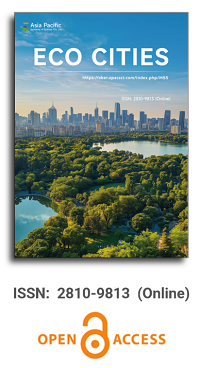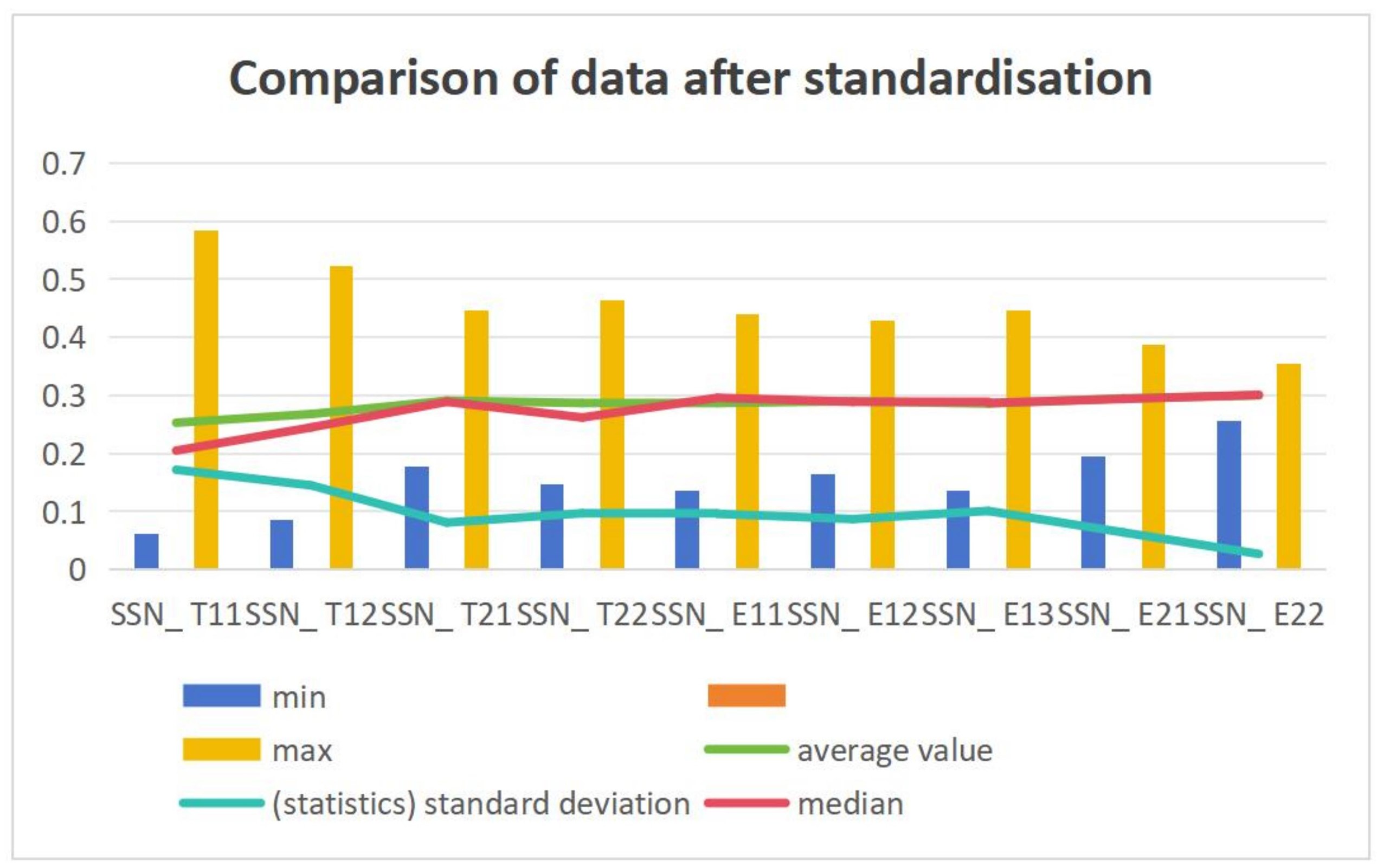


Charcoal briquetting: Alternative energy sources and waste management solution for sustainable cities in Tanzania
Vol 5, Issue 1, 2024
Download PDF
Abstract
This paper presents a report as part of a comprehensive study on the utilization of some forms of solid waste (SW) to make charcoal briquettes (CB) as an alternative fuel source in communities that are reliant upon traditional charcoal (TC) and wood as the primary cooking fuels. The study coincides with the Tanzanian government’s efforts to diminish reliance on wood and charcoal as a primary fuel source, particularly for large-scale consumers. Nevertheless, the government restriction on TC usage comes with little or no presentation of alternative sources that are both eco-friendly and economically sustainable. Introducing the mechanism that meets both environmental and economic criteria, the study employs a cross-sectional approach to collect the required data and uses experimental methods to evaluate the performance of the produced CB. Such tests focused on cooking duration, burning rate (BR), specific fuel consumption (SFC), and the general efficiency expressed by the percentage of heat utilized (PHU). In most cases, CB performs by far or less well than TC. Such results make the study important as it develops clean cooking technologies to solve the existing fuel crisis and improve health and environmental conditions from SW pollution while reducing deforestation, subsequent desertification, and climate change for sustainable environmental conservation.
Keywords
References
- Sloan S, Sayer JA. Forest Resources Assessment of 2015 shows positive global trends but forest loss and degradation persist in poor tropical countries. Forest Ecology and Management. 2015, 352: 134-145. doi: 10.1016/j.foreco.2015.06.013
- Angelo B. Lands of the Poor: Local Environmental Governance and the Decentralized Management of Natural Resources. United Nations Capital Development Fund; 2004. pp. 68-69.
- Mamo G, Sjaastad E, Vedeld P. Economic dependence on forest resources: A case from Dendi District, Ethiopia. Forest Policy and Economics. 2007, 9(8): 916-927. doi: 10.1016/j.forpol.2006.08.001
- Heist Q. Deforestation in Tanzania threatens the future of forests. Available online: https://projectgaia.com/deforestation-in-tanzania-threatens-the-future-of-forests/,2015 (accessed on 8 January 2024).
- Godoy FL, Tabor K, Burgess ND, et al. Deforestation and CO2 emissions in coastal Tanzania from 1990 to 2007. Environmental Conservation. 2011, 39(1): 62-71. doi: 10.1017/s037689291100035x
- Msuya N, Masanja E, Temu AK. Environmental Burden of Charcoal Production and Use in Dar es Salaam, Tanzania. Journal of Environmental Protection. 2011, 02(10): 1364-1369. doi: 10.4236/jep.2011.210158
- Gladstone S, Tersigni V, Kennedy J, et al. Targeting Briquetting as an Alternative Fuel Source in Tanzania. Procedia Engineering. 2014, 78: 287-291. doi: 10.1016/j.proeng.2014.07.069
- Okoko A, Reinhard J, von Dach SW, et al. The carbon footprints of alternative value chains for biomass energy for cooking in Kenya and Tanzania. Sustainable Energy Technologies and Assessments. 2017, 22: 124-133. doi: 10.1016/j.seta.2017.02.017
- Gladstone S, Tersigni V, Kennedy J, et al. Targeting Briquetting as an Alternative Fuel Source in Tanzania. Procedia Engineering. 2014, 78: 287-291. doi: 10.1016/j.proeng.2014.07.069
- Felix M. Future prospect and sustainability of wood fuel resources in Tanzania. Renewable and Sustainable Energy Reviews. 2015, 51: 856-862. doi: 10.1016/j.rser.2015.06.034
- Ishengoma RC, Abdallah JM. Charcoal market conditions in 2016 in Dar es Salaam and Morogoro, Tanzania. Available online: https://www.tfcg.org/wp-content/uploads/2018/06/TTCS-Technical-Report-4-Ishengoma-Charcoal-Market-Conditions-in-Tanzania-2016.doc.pdf (accessed on 8 January 2024).
- Monela GC, O'Kting'ati A, Kiwele PM. Socio-economic aspects of charcoal consumption and environmental consequences along the Dar es Salaam-Morogoro highway, Tanzania. Forest ecology and management. 1993, 58(3-4): 249-258. doi: 10.1016/0378-1127(93)90148-G
- Luoga EJ, Witkowaki ET, Balkwill K. Economics of charcoal production in miombo woodlands of eastern Tanzania: some hidden cost associated with commercialization of the resources. Ecological Economics. 2000, 35(2): 243-257. doi: 10.1016/S0921-8009(00)00196-8
- Dos Santos AS, Tarimo MC, Kweka AR, Michael MA. Impacts of Human Induced Activities on Species Composition and Diversity in Miombo Woodlands of Bagamoyo District, Tanzania. Asian Journal of African Studies. 2006, 20: 223-243.
- Kilahama F. Impact of increased charcoal consumption to forests and woodlands in Tanzania 2009. Available online: http://www.tfcg.org/what-we-do/develop/sustainable-charcoal/ (accessed on 5 June 2020).
- World Health Organization. Household Air Pollution and Health. World Health Organization; 2018.
- UN-HABITAT. Solid Waste Management in the World’s Cities: Water and Sanitation in the World’s Cities. United Nations Human Settlements Programme; 2010. pp. 1-228.
- UNEP. Converting Waste Plastics into a Resource: Assessment, Guidelines. DTIE- Division of Technology, Industry and Economics: United Nations Environment Programme, IETC (International Environmental Technology Centre); 2009. pp. 73-74.
- Kazuva E, Zhang J. Analyzing Municipal Solid Waste Treatment Scenarios in Rapidly Urbanizing Cities in Developing Countries: The Case of Dar es Salaam, Tanzania. International Journal of Environmental Research and Public Health. 2019, 16(11): 2035. doi: 10.3390/ijerph16112035
- Xia G, Liu T, Wang Z, et al. The effect of silver nanoparticles on zebrafish embryonic development and toxicology. Artificial Cells, Nanomedicine, and Biotechnology. 2016, 44(4): 1116-1121. doi: 10.3109/21691401.2015.1011803
- Awasthi AK, Zeng X, Li J. Environmental pollution of electronic waste recycling in India: A critical review. Environmental Pollution. 2016, 211: 259-270. doi: 10.1016/j.envpol.2015.11.027
- Abu Qdais HA. Techno-economic assessment of municipal solid waste management in Jordan. Waste Management. 2007, 27(11): 1666-1672. doi: 10.1016/j.wasman.2006.08.004
- Pandyaswargo AH, Premakumara DGJ. Financial sustainability of modern composting: the economically optimal scale for municipal waste composting plant in developing Asia. International Journal of Recycling of Organic Waste in Agriculture. 2014, 3(3). doi: 10.1007/s40093-014-0066-y
- Singh RP, Tyagi VV, Allen T, et al. An overview for exploring the possibilities of energy generation from municipal solid waste (MSW) in Indian scenario. Renewable and Sustainable Energy Reviews. 2011, 15(9): 4797-4808. doi: 10.1016/j.rser.2011.07.071
- Narayana T. Municipal solid waste management in India: From waste disposal to recovery of resources? Waste Management. 2009, 29(3): 1163-1166. doi: 10.1016/j.wasman.2008.06.038
- Hosier R. Informal Sector Energy Use in Tanzania: Efficiency and Employment Potential. Stockholm Environment Institute, SIDA; 1994.
- Quirós R, Gabarrell X, Villalba G, et al. The application of LCA to alternative methods for treating the organic fiber produced from autoclaving unsorted municipal solid waste: case study of Catalonia. Journal of Cleaner Production. 2015, 107: 516-528. doi: 10.1016/j.jclepro.2014.04.018
- Astrup TF, Tonini D, Turconi R, et al. Life cycle assessment of thermal Waste-to-Energy technologies: Review and recommendations. Waste Management. 2015, 37: 104-115. doi: 10.1016/j.wasman.2014.06.011
- Cheremisinoff NP. Source reduction and waste minimization. In: Handbook of Solid Waste Management and Waste Minimization Technologies, 1st ed. Butterworth-Heinemann; 2003. pp. 1-22. doi: 10.1016/b978-075067507-9/50002-4
- Diamadopoulos E, Koutsantonakis Y, Zaglara V. Optimal design of municipal solid waste recycling systems. Resources Conservation Recycling. 1995, 14(1): 21-34. doi: 10.1016/0921-3449(94)00051-6
- Bolaji BO. The Use of Sawdust as An Alternative Source of Energy for Domestic Cooking and as a Means of Reducing Deforestation. Global Journal of Environmental Sciences. 2005, 4(1). doi: 10.4314/gjes.v4i1.2444
- Smith KR. Health impacts of household fuelwood use in developing countries. Unasylva. 2006, 57(224): 41-44.
- Kazuva E, Zhang J, Tong Z, et al. GIS- and MCD-based suitability assessment for optimized location of solid waste landfills in Dar es Salaam, Tanzania. Environmental Science and Pollution Research. 2020, 28(9): 11259-11278. doi: 10.1007/s11356-020-11213-0
- Kazuva E, Zhang J, Tong Z, et al. The DPSIR Model for Environmental Risk Assessment of Municipal Solid Waste in Dar es Salaam City, Tanzania. International Journal of Environmental Research and Public Health. 2018, 15(8): 1692. doi: 10.3390/ijerph15081692
- Kazuva E, Zhang J. Environmental Risk Indices for Municipal Solid Waste in the City of Dar es Salaam, Tanzania: Assessing Pressure-Response Relationship. International Journal of Engineering Management. 2018, 2(4): 93-103.
- Mirdar Harijani A, Mansour S, Karimi B. A multi-objective model for sustainable recycling of municipal solid waste. Waste Management & Research: The Journal for a Sustainable Circular Economy. 2017, 35(4): 387-399. doi: 10.1177/0734242x17693685
- Mirdar Harijani A, Mansour S, Karimi B, et al. Multi-period sustainable and integrated recycling network for municipal solid waste – A case study in Tehran. Journal of Cleaner Production. 2017, 151: 96-108. doi: 10.1016/j.jclepro.2017.03.030
- Song J, Song D. A Decision-Making Model of Concession Period for Municipal Solid Waste Incineration Build-Operate-Transfer Project. In: Proceedings of the 2009 International Conference on Management and Service Science; 20-22 September 2009; Beijing, China. pp. 1-4. doi: 10.1109/icmss.2009.5301118
- Beck BD. An evaluation of the US Environmental Protection Agency definition of a risk assessment. Human & Experimental Toxicology. 2006, 25(1): 3-5. doi: 10.1191/0960327106ht577oa
- Daskalopoulos E, Badr O, Probert SD. Municipal solid waste: a prediction methodology for the generation rate and composition in the European Union countries and the United States of America. Resources Conservation Recycling. 1998, 24(2): 155-166. doi: 10.1016/S0921-3449(98)00032-9
- Schaafsma M, Morse-Jones S, Posen P, et al. Towards transferable functions for extraction of Non-timber Forest Products: A case study on charcoal production in Tanzania. Ecological Economics. 2012, 80: 48-62. doi: 10.1016/j.ecolecon.2012.04.026
- Doggart N, Ruhinduka R, Meshack CK, et al. The influence of energy policy on charcoal consumption in urban households in Tanzania. Energy for Sustainable Development. 2020, 57: 200-213. doi: 10.1016/j.esd.2020.06.002
- Bushesha M. Adaptation to Climate Change Through Urban Forestry: Perceptions and Actions of Urban Residents in the Dar es Salaam City. Journal of The Geographical Association of Tanzania. 2021, 40(1). doi: 10.56279/jgat.v40i1.28
- Bamutaze Y, Kyamanywa S, Singh BR, et al. Agriculture and Ecosystem Resilience in Sub Saharan Africa. Springer International Publishing; 2019. doi: 10.1007/978-3-030-12974-3
- Fejes A, Nylund M, Wallin J. How do teachers interpret and transform entrepreneurship education? Journal of Curriculum Studies. 2018, 51(4): 554-566. doi: 10.1080/00220272.2018.1488998
- Badawi S, Reyad S, Khamis R, et al. Business education and entrepreneurial skills: Evidence from Arab universities. Journal of Education for Business. 2019, 94(5): 314-323. doi: 10.1080/08832323.2018.1534799
- Chidumayo EN, Gumbo DJ. The environmental impacts of charcoal production in tropical ecosystems of the world: A synthesis. Energy for Sustainable Development. 2013, 17(2): 86-94. doi: 10.1016/j.esd.2012.07.004
- Abdullah S, Ismail M, Ahmed A. Multi-layer perceptron model for air quality prediction. Malaysian Journal of Mathematical Sciences. 2019, 13: 85-95.
- Ullah S, Noor RS, Sanaullah, et al. Analysis of biofuel (briquette) production from forest biomass: a socioeconomic incentive towards deforestation. Biomass Conversion and Biorefinery. 2023, 13: 1-15. doi: 10.1007/s13399-021-01311-5
- Lee Y, Kreiser PM, Wrede AH, et al. University-Based Education and the Formation of Entrepreneurial Capabilities. Entrepreneurship Education and Pedagogy. 2018, 1(4): 304-329. doi: 10.1177/2515127418788893
- Cagliani A, Kjær D, Østerberg FW, et al. Multi-electrode probe geometry optimization for characterization of magnetic tunnel junction stacks. In: Proceedings of the 13th Joint MMM-Intermag Conference; 11-15 January 2016; San Diego, California, United States.
- Fisher B, Lewis SL, Burgess ND, et al. Implementation and opportunity costs of reducing deforestation and forest degradation in Tanzania. Nature Climate Change. 2011, 1(3): 161-164. doi: 10.1038/nclimate1119
- Mwampamba TH. Has the woodfuel crisis returned? Urban charcoal consumption in Tanzania and its implications to present and future forest availability. Energy Policy. 2007, 35(8): 4221-4234. doi: 10.1016/j.enpol.2007.02.010
- Hoffmann H, Uckert G, Rybak C, et al. Efficiency scenarios of charcoal production and consumption–a village case study from Western Tanzania. Food security. 2018, 10: 925-938. doi: 10.1007/s12571-018-0786-3
- D'Agostino AL, Urpelainen J, Xu A. Socio-economic determinants of charcoal expenditures in Tanzania: Evidence from panel data. Energy Economics. 2015, 49: 472-481. doi: 10.1016/j.eneco.2015.03.007
- The United Republic of Tanzania. National population projections. Available online: https://dc.sourceafrica.net/documents/119897-The-United-Republic-of-Tanzania-National.html (accessed on 8 January 2024).
- The World Bank. Upgrading of low income settlements: Country assessment report. Available online: http://web.mit.edu/urbanupgrading/upgrading/case-examples/overview-africa/country-assessments/reports/Tanzania-report.html (accessed on 23 January 2019).
- Huisman H, Breukelman H, Keesman B. Expert Mission on Integrated Solid Waste Management (ISWM) to Dar es Salaam. Available online: https://www.rvo.nl/sites/default/files/2016/11/Tanzania%20Report%20Expert%20Mission%20Solid%20Waste%202016.pdf (accessed on 8 January 2024).
- Kumar S, Dhar H, Nair VV, et al. Characterization of municipal solid waste in high-altitude sub-tropical regions. Environmental Technology. 2016, 37(20): 2627-2637. doi: 10.1080/09593330.2016.1158322
- Kirama A, Mayo AW. Challenges and prospects of private sector participation in solid waste management in Dar es Salaam City, Tanzania. Habitat International. 2016, 53: 195-205. doi: 10.1016/j.habitatint.2015.11.014
- Mbwette T, Kalwani J, Yohana L. Assessment on Vulnerable Youths Integration to Dar es Salaam Solid Waste Management for Improvement: Kinondoni Municipality Case. Huria. 2015, 20.
- Lohri CR, Faraji A, Ephata E, et al. Urban biowaste for solid fuel production: Waste suitability assessment and experimental carbonization in Dar es Salaam, Tanzania. Waste Management & Research: The Journal for a Sustainable Circular Eco Luoga Enomy. 2015, 33(2): 175-182. doi: 10.1177/0734242x14564644
- Sellin N, de Oliveiraa BG, Marangonia C, et al. Use of banana culture waste to produce briquettes. Chemical Engineering. 2013, 32: 349-354. doi: 10.3303/CET1332059
- Mizero M, Ndikumana T, Jung CG. Briquettes From Solid Waste: A substitute For Charcoal in Burundi. Available online: https://ideas.repec.org/p/sol/wpaper/2013-163796.html (accessed on 8 January 2024).
- Sulistyaningkarti L, Utami B. Making Charcoal Briquettes from Corncobs Organic Waste Using Variation of Type and Percentage of Adhesives. JKPK (Jurnal Kimia dan Pendidikan Kimia). 2017, 2(1): 43. doi: 10.20961/jkpk.v2i1.8518
- Prasityousil J, Muenjina A. Properties of Solid Fuel Briquettes Produced from Rejected Material of Municipal Waste Composting. Procedia Environmental Sciences. 2013, 17: 603-610. doi: 10.1016/j.proenv.2013.02.076
- Cuaresma CA, Elauria JC, Suministrado DC, et al. Utilization of Jatropha (Jatropha curcas L.) Wastes for Charcoal Briquettes. Journal of the Japan Institute of Energy. 2015, 94(10): 1110-1119. doi: 10.3775/jie.94.1110
- Lukmuang R, Dasaard C, Chantawong P, et al. Material Ratio Analysis of Charcoal Briquettes from Dendrocalamus Asper Backer Bamboo. IOP Conference Series: Materials Science and Engineering. 2019, 526(1): 012010. doi: 10.1088/1757-899x/526/1/012010
- Sudradjat R. Effects of raw material, binder and pressure on the quality of charcoal briquettes. Laporan Pusat Penelitian Dan Pengembangan Hasil Hutan Indonesia. 1983, 165: 7-17.
- Alabdraba W, AL-Qaraghully H. Composition of Domestic Solid Waste and The Determination of its Sensity & Moisture Content: A case study for Tikrit City, Iraq. International Review of Civil Engineering. 2013, 4(2).
- Abdel-Shafy HI, Mansour MSM. Solid waste issue: Sources, composition, disposal, recycling, and valorization. Egyptian Journal of Petroleum. 2018, 27(4): 1275-1290. doi: 10.1016/j.ejpe.2018.07.003
- Kumar AA, Jhansi R, Vardhan UH, et al. Development and Evaluation of Low Pressure Multi Briquetting Machine for Rural Areas. Current Journal of Applied Science and Technology. 2019, 34(1): 1-15. doi: 10.9734/cjast/2019/v34i130113
- Major BJ, Radu G. Briquette binder composition. Available online: https://patents.google.com/patent/US6013116A/en (accessed on 7 June 2020).
- Mopoung S, Udeye V. Characterization and Evaluation of Charcoal Briquettes Using Banana Peel and Banana Bunch Waste for Household Heating. American Journal of Engineering and Applied Sciences. 2017, 10(2): 353-365. doi: 10.3844/ajeassp.2017.353.365
- Ira MA, Seguenza J, Bongay C. Determination of physical and combustion properties of corncobs/rice bran briquettes with cassava and corn starch binder. 2022, 13(1): 16-27. doi: 10.5958/0976-4763.2022.00003.4
- Danshehu B, Sambo A, Musa M. Comparative Performance of Sawdust and Wood Burning Stove. Nigerian Journal Renewable energy. 1992, 3(2): 50-55.
- Amsler P, Sam D, Zorba H. Controlled Cooking Test: Full Documentation and Instructions. Rochester Institute of Technology; 2011. pp. 1-19.
- Hassan LG, Sani NA, Sokoto AM, etc. Comparative studies of burning rates and water boiling time of wood charcoal and briquettes produced from carbonized martynia annua woody shells. Nigerian Journal of basic and applied sciences. 2017, 25(2): 21-27. doi: 10.4314/njbas.v25i2.4
- Hakizimana J de DK, Kim HT. Peat briquette as an alternative to cooking fuel: A techno-economic viability assessment in Rwanda. Energy. 2016, 102: 453-464. doi: 10.1016/j.energy.2016.02.073
- Mandal S, Kumar A, Singh RK, et al. Drying, burning and emission characteristics of beehive charcoal briquettes: An alternative household fuel of Eastern Himalayan Region. Journal of Environmental Biology. 2014, 35(3): 543.
- Otake T, Ota R, Shishido M, et al. The Preparation of Briquettes from Architectural Waste Wood Charcoal and Evaluation of their Characteristics. Journal of the Japan Society of Material Cycles and Waste Management. 2009, 20(2): 133-140. doi: 10.3985/jjsmcwm.20.133
- Adegoke CO. A Preliminary Investigation of Sawdust as High-grade Solid Fuel. Nigerian Journal Renewable Energy. 1999, 7(1&2): 102-107.
- Tanui JK, Kioni PN, Kariuki, et al. Influence of processing conditions on the quality of briquettes produced by recycling charcoal dust. International Journal of Energy and Environmental Engineering. 2018, 9: 341-350. doi: 10.1007/s40095-018-0275-7
Supporting Agencies
Copyright (c) 2024 Emmanuel Kazuva
License URL: https://creativecommons.org/licenses/by/4.0/

This site is licensed under a Creative Commons Attribution 4.0 International License (CC BY 4.0).

Chinese Academy of Sciences, China
Indexing & Archiving
Asia Pacific Academy of Science Pte. Ltd. (APACSCI) specializes in international journal publishing. APACSCI adopts the open access publishing model and provides an important communication bridge for academic groups whose interest fields include engineering, technology, medicine, computer, mathematics, agriculture and forestry, and environment.



.jpg)

.jpg)



